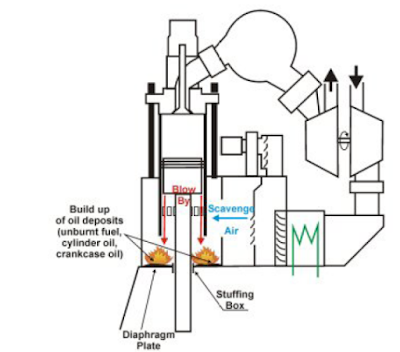 |
| Scavenge Fire |
The combustion material for scavenge fire is oil.
- It can be cylinder oil which is drained from cylinder spaces,
- crankcase oil carried upwards due to faulty stuffing box or
- fuel oil from defective injectors, injectors with incorrect pressure settings,
The oxygen necessary for combustion comes from scavenge air which is available in abundance.
CAUSES :
The source of heat for ignition can be due to piston blow past which may be due to
- sticking or broken piston rings or
- excessive liner wear.
- Faulty combustion due to late injection or incorrect atomization may also be responsible as it will cause blow back of exhaust through the scavenge ports.
INDICATIONS :
- Loss in power and irregular running of the engine
- High exhaust temperature of corresponding unit
- High local temperature in scavenge trunk.
- Surging of turbochargers
- Sparks and smokes emitted from scavenge drains
- External indication will be given by smoky exhaust and soot and carbon particles in the exhaust.
- In modern UMS ships, temperature sensors are fitted which will activate alarm and cause automatic slow down of the engine.
ACTION : If a scavenge fire is detected the immediate objective is to contain the fire within the scavenge space of the engine and to prevent or minimize the damage to the engine.
- Reduce the speed of the engine
- Cut off fuel to affected cylinder.
- Increase the cylinder lubrication of the affected cylinder to prevent seizure.
- Close all the scavenge drains to prevent the discharge of sparks, smoke in the engine room.
- Personnel should stay clear of the scavenge relief doors.
A minor fire will shortly burn out without damage, and conditions will gradually return to normal. The affected units must be run on reduced power until inspection of scavenging trunking and overhaul of cylinder and piston can be carried out at earliest opportunity. The actual cause of fire should be investigated.
If the scavenge fire is a major one or if there are chances of fire spreading to the adjacent spaces,
- engine should be stopped, normal cooling should be maintained
- turning gear should be engaged and engine turned or turning gear.
- Fire extinguishing medium should be applied through the fittings in the scavenge trunk. This may be CO2, dry powder or smothering steam.
- Boundary cooling of the scavenge manifold may be necessary.
- Scavenge manifold should not be opened until the engine has cooled down.
PREVENTION :
- Scavenge trunk must be periodically inspected and cleaned. Any build up of contamination to be noted and rectified.
- To carry out inspection through scavenge ports at regular interval and monitor the condition of piston, piston rings and liner.
- Scavenge drains should be cleaned regularly and ensured that they are clear.
- Piston rings must be properly maintained and lubricated adequately so that blow by is prevented.
- Ensure cylinder lubrication timing and quantity is correct.
- Fuel injection equipment to be maintained in good condition.
- If the cylinder liner wear has reached its maximum limit the possibility of scavenge fire will not be reduced until the liner is renewed.
Author marineGuru
















Post a Comment